What you need to know about caffeine
If you have a cup of coffee after 5 p.m., chances are you’ll be wired and restless for the rest of the night. Coffee, tea, and carbonated beverages like cola, are obvious sources of caffeine. But, did you know that having that protein bar before your nightly gym class contains caffeine too?
There are many surprising and hidden sources of caffeine in food and drinks that you may not be aware of. It’s important to stay on top of all sources of caffeine intake. The 2015-2020 U.S. Dietary Guidelines for Americans advises that adults have no more than 400 milligrams caffeine per day.
“Some people can have adverse reactions when consuming greater than this amount of caffeine,” says Emily Rubin, RD, registered dietitian and director of clinical nutrition in the division of gastroenterology and hepatology at Thomas Jefferson University Hospital, in Philadelphia. “They may experience sleeping problems, restlessness, heartburn, or diarrhea.”
Women who are pregnant should be even more careful about watching their caffeine intake. “According to the American Pregnancy Association (APA), caffeine is generally safe for pregnant and nursing women,” advises Rubin. However, the APA states that pregnant women should take in less than 200 milligrams daily.
Now, let’s take a look at eight hidden sources of caffeine to help you keep track of your caffeine intake per day.
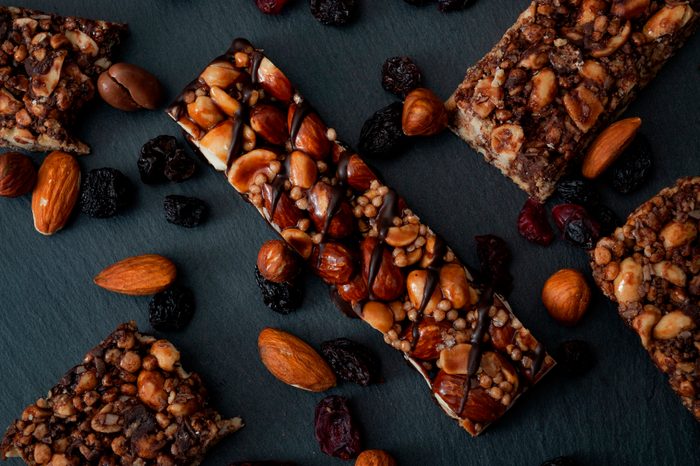
Protein bars
This seems like a strange food to contain caffeine, right? Not necessarily, especially if a bar is coffee flavored—such as the PROBAR Coffee Crunch Protein bar, which contains 55 milligrams of caffeine. This caffeine comes from a mixture of coffee, cocoa, and yerba mate extract and is about the amount of caffeine that’s in a shot of espresso. Other caffeinated protein bars may contain less caffeine, such as the Garden of Life Organic Fit Protein Bar. The bar isn’t coffee-flavored, but is likely meant to provide energy via the green coffee bean extract it contains. This ingredient lands the bar at 4 milligrams caffeine, according to iHerb.com. While this isn’t a lot, it’s best to avoid eating the bar at bedtime, notes Heidi Deboo Moretti, RDN, a registered dietitian nutritionist at Thyroid Nutrition Educators. Here are 7 recipes for making your own protein bars, sans caffeine.
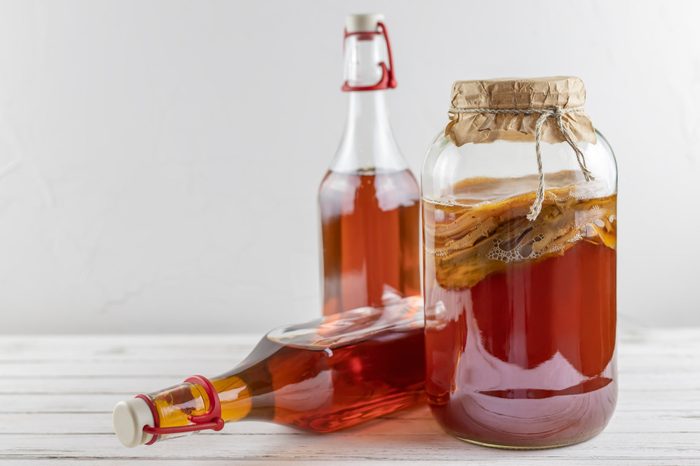
Kombucha
It makes sense that kombucha, which is tea based, provides caffeine. “Kombucha is brewed from black or green tea, and these teas naturally have caffeine,” says Rubin. The average kombucha contains about 45 milligrams caffeine per 15-ounce serving, according to Caffeine Informer. However, you might find higher amounts in certain offerings. KeVita’s Master Brew Kombucha Citrus, for instance, provides 68 milligrams per the same serving size. “This is because it’s made with green tea extract,” says Rubin. “Kombucha is known for its possible benefits for gut health, but many people would not know the popular drink has a caffeine content equivalent to a 20-ounce green tea.” (Check out the best kombucha brands to buy, according to dietitians.)
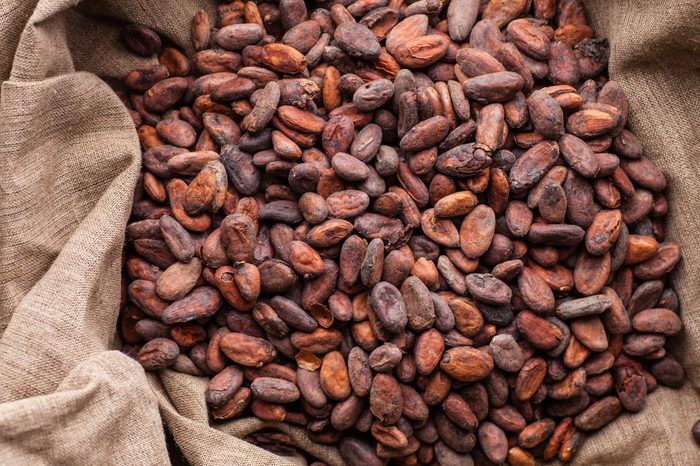
Chocolate desserts
Yup, chocolate contains caffeine. “Caffeine is found naturally in cocoa beans,” says Rubin. “When cocoa beans are liquefied to make chocolate, that liquid contains cocoa butter and cocoa solids.” Lindt notes that a 1-ounce serving of its dark chocolate typically provides about 20 milligrams of caffeine. Although dark chocolate boasts more health benefits than other varieties, you may want to reach for milk chocolate (6 milligrams per ounce) or white chocolate (less than 2 milligrams per ounce) if you’re trying to cap your daily caffeine intake. “Caffeine is only found in cocoa solids, not in cocoa butter,” explains Rubin. White chocolate is made with cocoa butter.
Desserts prepared with chocolate or cocoa powder also contain caffeine. These include chocolate pudding. Per the U.S. Department of Agriculture (USDA), a 4-ounce snack-size serving of chocolate pudding has a little over 2 milligrams caffeine. “The darker the pudding, the more caffeine it has because more cocoa powder has been used,” says Rubin. This is what happens to your body when you eat chocolate.
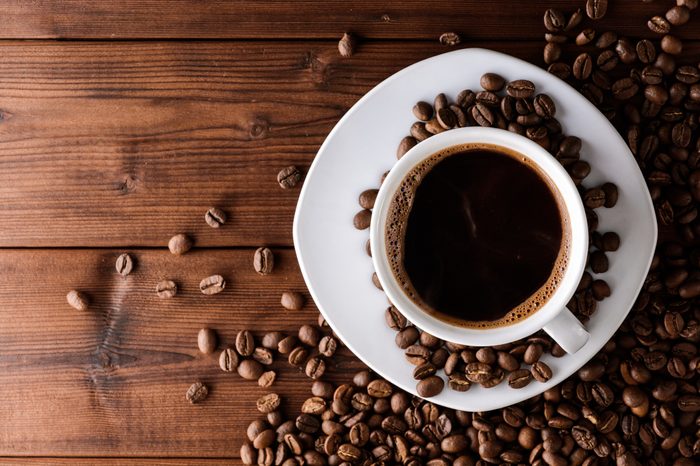
Decaf coffee
“People might be surprised to know there is caffeine in decaf coffee,” says Katie Sullivan Morford, a registered dietitian in San Francisco. “Decaf coffee has caffeine because the methods used to extract it from coffee beans aren’t entirely effective—and some caffeine remains.” The amount of caffeine in decaf coffee ranges. A 16-ounce serving of Starbuck’s Decaf Pike Place Roast provides 25 milligrams of caffeine, for instance. “For folks who are really sensitive to caffeine or who are drinking multiple cups of decaf and thinking they’re enjoying caffeine-free drinks, this could be a problem,” says Sullivan Morford.
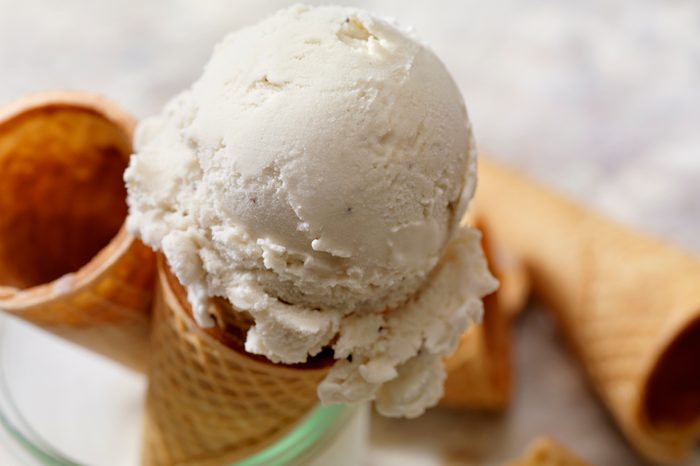
Ice cream
This popular after-dinner dessert can contain caffeine. “As for chocolate and coffee ice cream, it follows that the ice cream might contain caffeine because it’s made with a caffeine-containing ingredient,” says Sullivan Morford. While Häagen-Dazs states on its website that caffeine levels in its ice cream (per a 2/3-cup serving) or ice cream bars can go all the way up to 35 milligrams, Bon Appétit reports that a 2/3-cup serving of Häagen-Dazs coffee ice cream will put you at about 29 milligrams caffeine.
Coffee ice cream isn’t the only variety of ice cream supplying caffeine. Other flavors that contain coffee and chocolate, such as Java Chip, also boast caffeine. Chocolate ice cream will likely contain less caffeine than coffee ice cream, though. “By the time chocolate is turned into ice cream—with the addition of milk, cream, and sugar—it likely has very little caffeine.,” says Sullivan Morford. (See the 11 food trends that will be everywhere in 2020.)
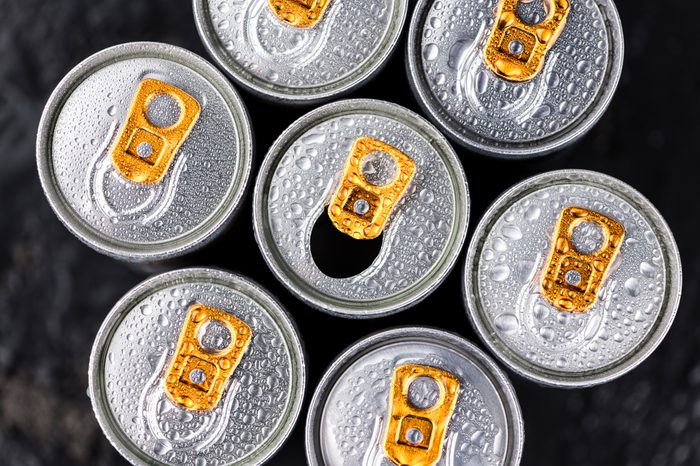
Energy drinks
Not all energy drinks have the word “energy” in their names. But most of them contain caffeine. “A fellow dietitian tried Bai for the first time and couldn’t figure out why she was up all night,” says Colleen Wysocki, a registered dietitian nutritionist in Capitola, California. In a 16-ounce bottle of Bai, you get 70 milligrams of caffeine. “This can definitely take someone by surprise if she drinks the entire bottle,” notes Wysocki. The caffeine comes from coffee fruit extract and white tea extract. “You get the caffeine equivalent of two cups of black tea or a cup of instant coffee,” adds Lauren Harris-Pincus, registered dietitian and author of The Protein-Packed Breakfast Club.
And in V8+Energy, you receive a combo of vegetable juice, fruit juice, B vitamins—and caffeine. The caffeine is from black and green tea. “An 8-ounce can actually has less caffeine than a typical cup of coffee, 80 milligrams, an amount that’s not so crazy,” says Rosanne Rust, RD, a registered dietitian in Meadville, Pennsylvania. The typical energy drink can contain up to 200 milligrams caffeine per can, according to Caffeine Informer. (Here’s what energy drinks really do to your body.)
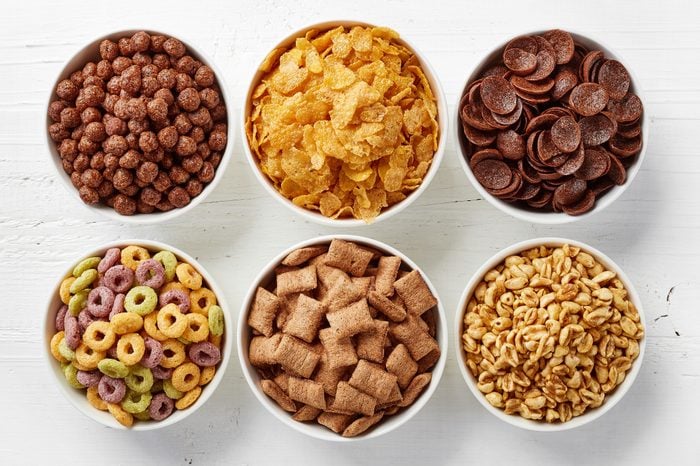
Cereal
It might make sense that a chocolate-flavored cereal contributes caffeine to your day. Take Cocoa Puffs, for example. This “chocolate-y” cereal contains cocoa, a source of caffeine. A ¾-cup serving has almost 2 milligrams caffeine, per the USDA. You’ll find cereal made with trendy matcha green tea powder, too, such as gr8nola Matcha Green Tea. While the brand doesn’t list the amount that you get per serving, know this: Matcha has 68 milligrams caffeine per teaspoon, according to GotMatcha.com. “I suppose caffeinated cereal or protein bars would be desirable by some people to provide an energy boost if you don’t like coffee, don’t have easy access to it, or are looking for an edible source of caffeine,” says Harris-Pincus. (Get more food facts that will change how you eat.)
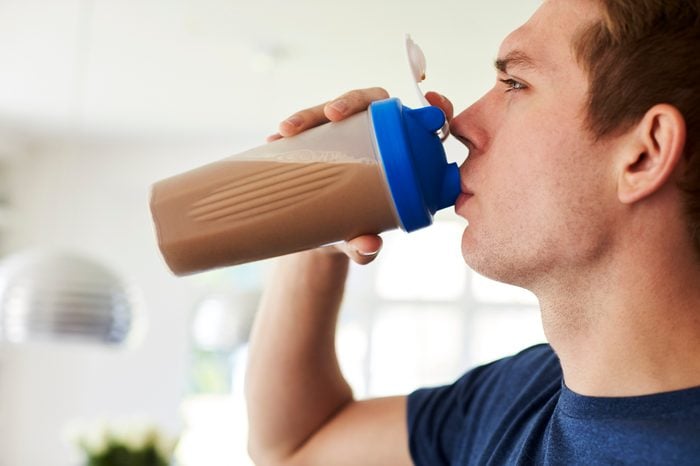
Protein drinks
Many protein drinks don’t contain caffeine. But some, such as Ensure Max Protein Café Mocha, do. The nutritional supplement provides 30 grams of protein and 100 milligrams of caffeine. “I’m sure you would find it surprising that a nutritional supplement typically used when someone presents with decreased appetite or muscle wasting contains caffeine,” says Wendy Kaplan, MS, RDN, an oncology dietitian in New York City. “The Café Mocha flavor of the Ensure Max Protein line by Abbott is the only flavor in that line that has 100 milligrams caffeine. This is not necessarily a bad thing, and may even be a pro, but is very important to know.”
